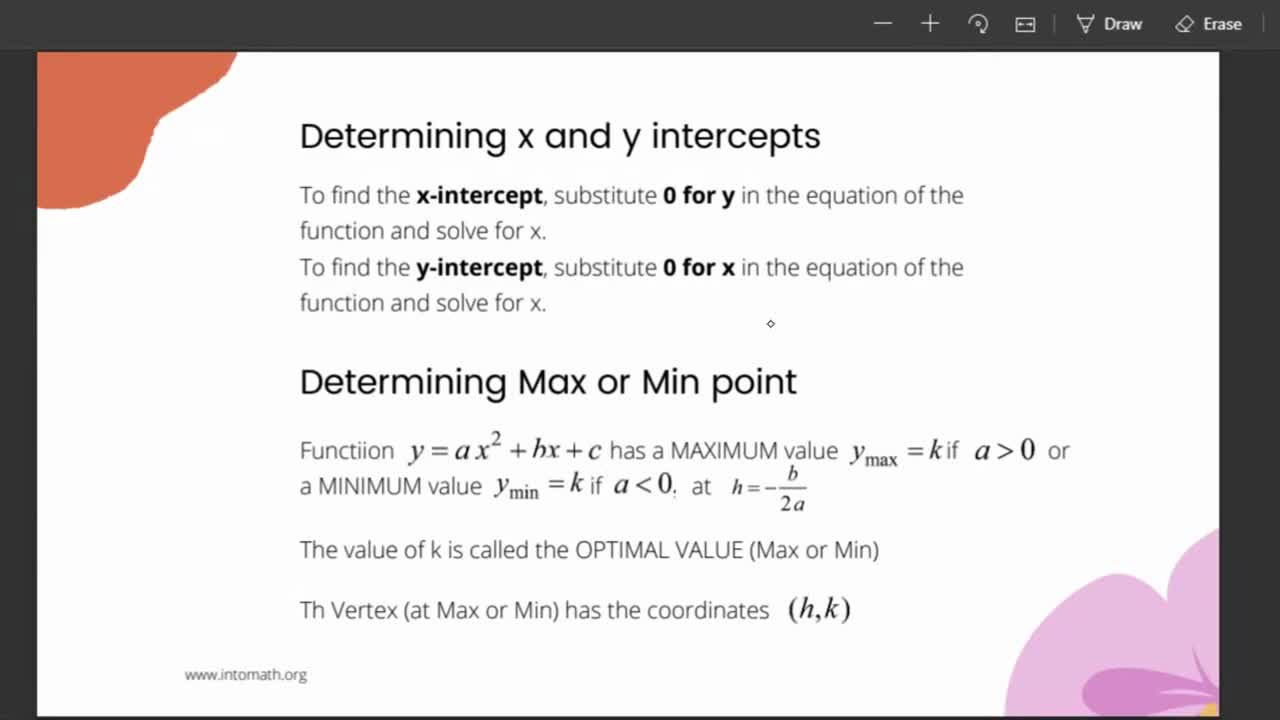Premium Only Content

Quadratic function and its graph explained - IntoMath
A quadratic function is a function of the form f(x) = ax2 + bx + c, where a cannot be 0. This is called a standard form equation. There are two other forms: vertex and factored. The graph of a quadratic function is called a parabola. Parabolas may open upward or downward. They have the “U” shape.
The most basic parabola has an equation f(x) = x2. In order to graph this parabola, we can create the table of values, where x is the independent input and f(x) is the output of a squared input.
The vertex of a parabola is its the highest or the lowest point. When a quadratic equation is given in the vertex form, it is easy to immediately determine the vertex by looking at the values of k and h. They are the coordinates of the vertex.
f(x) = a(x – h)2 + k Vertex (h,k)
Sometimes it is necessary to convert the standard form equation to a vertex form equation. In order to do that, we can use a process called “completing the square”. We can also complete the square geometrically.
We can also use the method of completing a square to solve certain types of quadratic equations for zeros (x-intercepts) and determine where parabola intersects with the x-axis.
Quadratic functions are very common in real life. Remember the Angry Birds game and movie? In order to design the game, the creators had to have a good understanding of a parabolic trajectory. A trajectory of a kicked ball or a diver diving off of the board are also described by parabolas. In basketball a quadratic functions are used to calculate the exact position of the player in order to get the ball in the net.
More free math help and activities: intomath.org
-
 6:54
6:54
KTNV
4 years agoFashion + Function
166 -
 1:52
1:52
WXYZ
4 years ago'Renter death penalty' explained
1.11K -
 1:21:47
1:21:47
ChaseThePatriot
4 years ago $0.14 earnedElection Chaos Explained
286 -
 4:48
4:48
IntoMath Grade 6 Lessons
3 years ago $0.04 earnedDecimals - Place value - IntoMath
2841 -
 2:17
2:17
WXYZ
4 years agoDetroit's Proposal N explained
22 -
 4:19
4:19
HotZone
3 years ago $0.02 earnedThe Ethiopian Crisis Explained
234 -
 2:40:43
2:40:43
The Charlie Kirk Show
4 years agoBOMBSHELL VOTER FRAUD CLAIMS EXPLAINED
14.5K34 -
 0:39
0:39
KTNV
4 years agoPUA online appeals function
8 -
 13:08
13:08
TheDisciple
4 years agoRevelation 12 signs explained
414 -
 3:20
3:20
IntoMath Grade 5 Lessons
3 years ago $0.05 earnedDecimals and their properties - IntoMath
2061